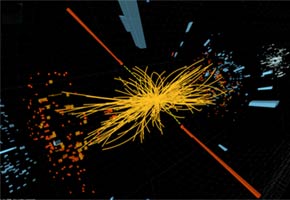

Brazilian researchers participate in one of the groups involved in the search for the so-called "God particle"
Brazilian researchers participate in one of the groups involved in the search for the so-called "God particle"
Brazilian researchers participate in one of the groups involved in the search for the so-called "God particle"

Brazilian researchers participate in one of the groups involved in the search for the so-called "God particle"
By Elton Alisson
Agência FAPESP – Scientists of the European Organisation for Nuclear Research (Cern) announced during a seminar held in Geneva, Switzerland on December 13, 2011 that they had found clues to the location of the Higgs boson. The theoretical elementary particle, nicknamed the “God Particle,” is believed to be the first particle containing mass after the Big Bang and the key to explaining the origin of mass in other elementary particles.
Using samples of data from proton collisions collected through the end of 2011 from the Large Hadron Collider and two of Cern’s main research groups, Atlas and CMS, the researchers managed to eliminate a broad range of possible mass values for the Higgs boson. With this advance, the search for the Higgs boson can now concentrate on a much narrower mass range.
“The results are very exciting. We now have a small range where it is possible that the Higgs boson is located. However, we must be cautious because the results are not conclusive,” commented Sérgio Novaes, professor at Universidade Estadual Paulista (Unesp), in an interview with Agência FAPESP.
Novaes is a member of one of the two groups of scientists that are searching for the Higgs boson at Cern, the Compact Muon Solenoid (CMS), and coordinator of the Sprace thematic project, conducted with FAPESP funding.
Through the Sprace project, Brazilian researchers are operating a data processing network and participate in the analysis of data produced by CMS.
“We had diverse students conducting master’s and doctoral research at Cern. Our idea now is to begin to participate more consistently in CMS’ hardware and broaden our participation in the experiment as a whole,” said Novaes.
Using the sample of proton collision data previously collected by Cern, researchers in the CMS group announced today that if the Higgs Boson exists, there is a 95% probability that it will not be found in the 127 to 600 GeV (gigaelectron volt) mass range. They also identified the 115 to 127 GeV mass range as the most probable location of this particle.
The Atlas group obtained results similar to those found by CMS. Working totally independently from CMS without any other form of interaction among the groups, the Atlas scientists eliminated the possibility of finding the Higgs boson in particles with a mass between 141 and 476 GeV and indicated that the particle could have a mass between 116 and 130 GeV.
“It is absolutely surprising that the two experiments were conducted independently without either group having access to the data of the other and that such similar results were nevertheless obtained,” states Novaes.
Now the two research groups should publish their results and will later meet to combine their data.
According to estimates by Cern researchers, it will only be possible to clearly establish the existence or nonexistence of the Higgs boson in the mass range defined by the CMS and Atlas groups at the end of 2012, when a greater number of proton collision data will be available.
According to the researchers, the group must have twice the data that they currently have to reach a solid conclusion.
“The challenge now is to control the anxiety that has built up over the past 45 years a little longer until we can prove or disprove the existence of the Higgs boson. I think the final result is near,” said Novaes.
The particle was first postulated by British scientist Peter Higgs. Higgs, with several other physicists, proposed the idea that a theoretical mechanism existed that would allow particles to have mass.
In 1967, this theoretical mechanism was incorporated by U.S. physicist Steven Weinberg into his theory to explain the elementary particles of the Universe, the so-called Standard Model. According to this theory, the universe cooled down after the Big Bang when an invisible force, known as the Higgs Field, formed along with associated particles, the Higgs bosons, and transferred mass to other fundamental particles.
Following the launch of this theory, scientists have been attempting to discover the Higgs boson. The signs of its presence have been extracted from large amounts of similar data, and the production of large number of events to certify a discovery.
“It’s literally like trying to find a needle in a haystack. It is extremely complex to extract a sign of the existence of the Higgs boson,” states Novaes.
According to Novaes, the search for the Higgs boson is only possible due to the development of new technology by scientists and engineers from diverse research institutions worldwide. This technology is being implemented for other disciplines, such as medicine and computing.
Republish
The Agency FAPESP licenses news via Creative Commons (CC-BY-NC-ND) so that they can be republished free of charge and in a simple way by other digital or printed vehicles. Agência FAPESP must be credited as the source of the content being republished and the name of the reporter (if any) must be attributed. Using the HMTL button below allows compliance with these rules, detailed in Digital Republishing Policy FAPESP.





